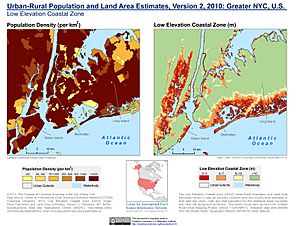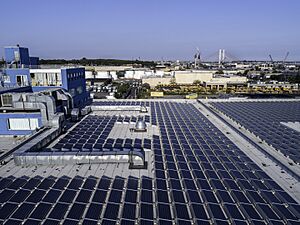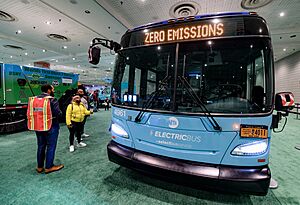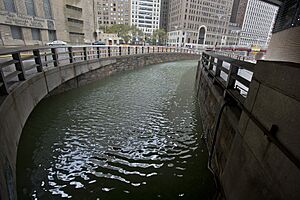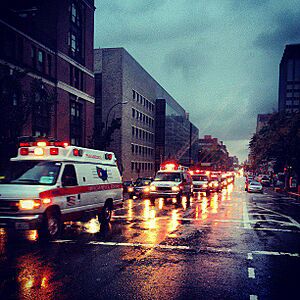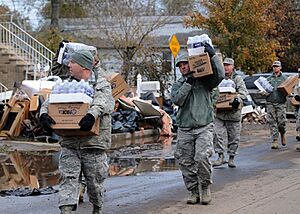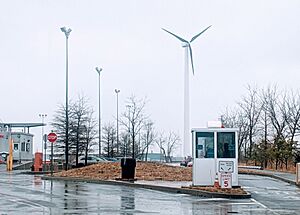Climate change in New York City facts for kids
Climate change is a big deal for New York City. Because so many people live here and there's so much infrastructure (like buildings, roads, and bridges), the city is especially at risk. Rising sea levels could affect buildings, wetlands, and even the city's water supply. New York is a major seaport, so its many bridges and tunnels are vulnerable to flooding. Big places like airports and the cruise ship terminal could also flood. This kind of flooding would be very expensive to fix. Since 1860, the sea level in New York has already risen by about 50 centimeters (20 inches).

Warmer temperatures can also cause more heat waves, which means more people could get sick or even die from the heat. Air pollution, like ground-level ozone, might also increase, leading to breathing problems such as asthma. The New York Times newspaper has even suggested that milder winters, due to climate change, are helping rats survive and have more babies, leading to more rats in the city. In June 2019, New York City officially declared a "climate emergency."
Contents
Fighting Climate Change
New York City is working hard to reduce its impact on climate change. The Mayor's Office, which also runs the OneNYC program, promised in 2018 to cut down on greenhouse gas emissions by 80% by the year 2050. This goal matches the target set by the Paris Agreement, an international plan to limit global warming. The city has already made progress, with emissions dropping by 15% since 2005.
New York City plans to create more ways for people to travel that don't produce a lot of carbon, like electric buses. They also want to improve city buildings to use less energy. In 2018, the city even sued five large energy companies (BP, Chevron, ConocoPhillips, Exxon Mobil, and Royal Dutch Shell). The city believes these companies are responsible for climate change and should help pay for the damage. New York City was also the first major U.S. city to stop investing its pension funds in fossil fuels, which are fuels like coal, oil, and natural gas that release carbon when burned. Mayor Bill de Blasio said that these companies should help make New York City safer from climate change.
The OneNYC program has also focused on using more renewable energy, which comes from natural sources like the sun and wind. For example, the number of solar power systems installed in the city has grown six times since 2014. The city has also invested a lot of money to make buildings more energy-efficient and to protect New York City's drinking water.
Protecting Against Flooding
Flooding is a serious danger. In 2018, it was the second biggest cause of weather-related deaths in the United States. Experts predict that the sea level in New York City could rise by 11 to 21 inches by 2050, and even more by 2100. This will make coastal flooding much worse.
When Hurricane Sandy hit in 2012, it caused a lot of damage and made people realize how important it is to protect the coast. Since then, rules have been made stronger to help the 400,000 New Yorkers who live in areas at high risk of flooding. In May 2017, New York Governor Andrew Cuomo announced plans to build a 5.3-mile-long seawall along the Staten Island coastline. This wall will be strong enough to stop floods even higher than Hurricane Sandy's floodwaters. When finished, it is expected to prevent about $30 million in damages.
Getting Ready for Change
In 2009, New York created a special group to help the city prepare for future challenges like flooding, water shortages, and hotter temperatures. The New York City water supply system is designed to meet the city's water needs. The Mayor's Office is investing $20 billion to help different neighborhoods in the city get ready for climate change threats, including flooding, heat, and rising sea levels.
One important project is the Lower Manhattan Coastal Resiliency initiative. This project aims to protect the Financial District and nearby areas from these threats.
In 2019, the city also put aside $615 million for a 5.1-mile project on Staten Island. This project, officially called the Staten Island Multi-Use Elevated Promenade, combines a seawall with a walkway.
What Causes Climate Change in NYC
New York City faces challenges in keeping its carbon emissions low. The Mayor's Office of Sustainability says that New York City produces 14 million tons of waste and recyclables every year.
Studies have shown that people living in single-family houses tend to produce more carbon emissions than those in multifamily buildings, because detached houses often use more energy. Many New Yorkers use public transportation like subways and buses because it's often cheaper and easier than driving a car. This widespread use of public transit helps reduce carbon emissions.
In 2003, New York was ranked among the 10% of U.S. counties with the worst air quality. The city only had good air quality on about 45% of days that year. To improve air quality, the city has worked to reduce, replace, and upgrade its vehicles. For example, in 2014, the city reduced its vehicle fleet by 5% and started using more biodiesel fuel. They also upgraded many vehicles to reduce pollution.
In Books
New York 2140 is a science fiction book from 2017 by American author Kim Stanley Robinson. It's set in New York City in the future, dealing with themes of climate change.


